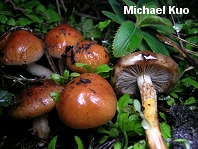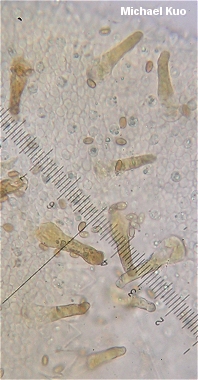| Major Groups > Gilled Mushrooms > Dark-Spored > Pholiota > Pholiota highlandensis |

|
Pholiota highlandensis species group [ Basidiomycetes > Agaricales > Strophariaceae > Pholiota . . . ] by Michael Kuo This group of Pholiota species is partial to burned areas, and the mushrooms appear in the years following the forest fire. Most of the species grow in dense clusters, often at the charred bases of trees that were blackened but not killed--or from buried wood, appearing to be terrestrial. They have slimy caps, brown to cinnamon brown spore prints, and partial veils that leave stringy or scaly remnants on the stem. The way the species in the group are currently separated is, to be frank, probably wrong. Differences in the color of the partial veil, the width of the stem, the taste, and the color of the cap separate 7 species in this group in the 1968 Smith & Hesler monograph of Pholiota. But this is not 1968, and we are learning again and again that minor differences in physical features are not always (dare I say "rarely?") indicative of actual genetic difference--and that morphology only helps to separate species when placed in other contexts (ecology, for example). So if you have found a slimy little clump of pholiotas in a burn site, you are welcome to try keying them out in the authoritative monograph (start here, in Section Carbonicola of Subgenus Flammuloides). I have just finished doing so, and I've labeled my collection from northern California "Pholiota cf. highlandensis" (cf. is Mycologese for Um, yeah, maybe). The description below is based on the official description of Pholiota highlandensis--but if your mushrooms differ on minor characters (cap color, veil color, no cystidia on the stem, etc.) you may want to consult Smith & Hesler . . . or you might easily find something better to do with your time. Description: Ecology: Saprobic; growing in clusters at the bases of charred trees, from burned wood, or on the ground in burned areas; spring through fall (also in winter in California); widely distributed in North America. Cap: 2-6 cm; convex, becoming broadly convex or nearly flat; thickly slimy when fresh; sometimes with small pale partial veil remnants near the margin; smooth; reddish brown to orange or orange brown with a paler margin, fading markedly to pale pinkish brown. Gills: Attached to the stem; close; whitish or yellowish at first, but eventually cinnamon brown; at first covered by a pale partial veil that may be covered with slime. Stem: 3-10 cm long; usually under 1 cm thick; white or yellowish near the apex; sheathed below the apex with scaly zones or patches of pale yellowish to buff-colored material; usually with a ring zone; whitish, yellowish, or very pale tan, becoming darker towards the base. Flesh: Pale yellow. Odor and Taste: Odor not distinctive; taste mild or unpleasant (radishlike in my collections). Chemical Reactions: In my collections, KOH turned the cap surface purple. Spore Print: Cinnamon brown. Microscopic Features: Spores 6-8 x 4-4.5 µ; smooth; more or less elliptical; with a tiny apical pore; pale brownish in Melzer's. Pleurocystidia fusoid-ventricose; thin-walled; brownish in KOH; up to 70 X 15 µ. Caulocystidia fusoid-ventricose, clavate, or merely cylindric; up to 90 X 15 µ; not aggregated into bundles. Clamp connections present. REFERENCES: (Peck, 1897) Smith & Hesler, 1968. (Smith & Hesler, 1968; Smith, Smith & Weber, 1979; Scates & Gospodnetich, 1981; Phillips, 1991/2005; Miller & Miller, 2006.) Herb. Kuo 01170509, 01170510. Further Online Information: Pholiota highlandensis in Smith & Hesler (1968) |
© MushroomExpert.Com |
|
Cite this page as: Kuo, M. (2006, December). Pholiota highlandensis species group. Retrieved from the MushroomExpert.Com Web site: http://www.mushroomexpert.com/pholiota_highlandensis.html |



